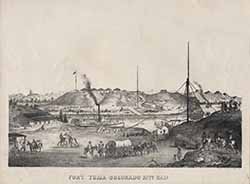History
Prior to the arrival of the Europeans there are estimated to have been between 10,000 and 20,000 River Yumans living in the lowland area. Long before the first Europeans ever stepped foot in their territory, however, their diseases—for which the tribes had no natural immunity- had already swept through the area. When the first Spaniard finally visited the area in 1776, he estimated the remaining population to be about 3000. Other than the rather substantial devastation caused by diseases, the River Yumans were largely unimpacted by Anglo contact until the mid-1800s. No missions or Spanish settlements were ever established in Mojave territory. The River Yumans were one of the few groups to have a true tribal consciousness. Tribes formed alliances with one another and appeared to be nearly constantly at warfare with members not in their alliance. There existed two opposing military alliances: the Quechan league, composed of the Mojave, Yavapai, Chemehuevi, Hia C-ed O'odham, and the western Tohono O'odham; and the Maricopa league, composed of the Cocopah, Halchidhoma, Hualapai, Havasupai, Akimel O'odham, and eastern Tohono O'odham. In the late 1820's the Quechan league ousted the Halchidhoma from the Colorado River valley and allowed the Chemehuevi to move into their abandoned territory. In 1858 the Mojave were defeated by the U.S. Army, and in 1862 the Colorado River Indian Reservation was established to the south of their traditional territory. Although this reservation was initially intended for the Mojave, only a fraction of the tribal members agreed to leave their homeland and relocate there. In addition to the Mojave that did resettle there, the Chemehuevi were placed on this reservation and later- after World War II—the federal government relocated some impoverished Hopi and Navajo families there as well. Today, this reservation is thus home to Mojave, Chemehuevi, Hopi and Navajo people, all of whom retain ties to their various heritages but collectively refer to themselves as "the Colorado River Indian Tribes" (or CRIT). The other reservations are the Fort Mojave Reservation (established in 1880 for the Mojave who had refused to leave their homeland) and the Gila River Reservation (shared by both Pima and Maricopa).
Instruction: Click on the thumbnail to see a zoomed picture of Fort Yuma.
By the 1850s, more and more Anglo settlers began to pass through Yuman territory and tensions grew between the Anglos and Indians.
Source - https://commons.wikimedia.org/w/index.php?curid=8009323
Click on next page to continue.

